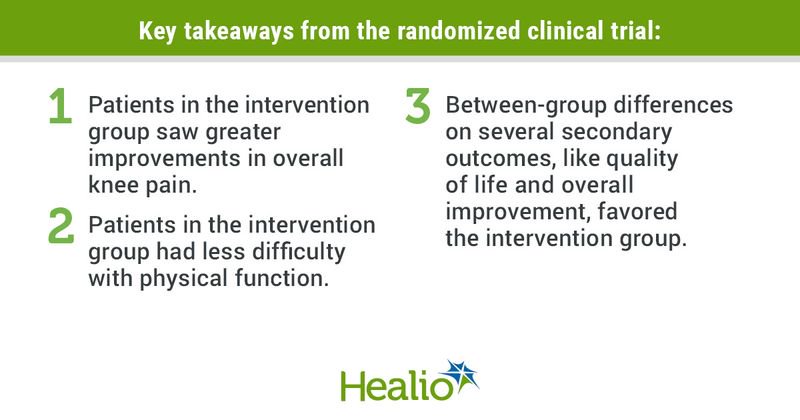Text message intervention improves knee osteoarthritis pain
Patients who received automated text messages that encouraged exercise adherence reported improvements in their knee osteoarthritis pain at 24 weeks, according to results from randomized clinical trial.
“Many people with knee osteoarthritis aren’t exercising,” Rachel Nelligan, PGCertPhysio, a PhD candidate and physiotherapist at the Centre for Health, Exercise and Sports Medicine at the University of Melbourne in Australia, told Healio Primary Care. “One key reason is because accessing appropriate treatment is challenging. Another reason is that finding the motivation to exercise is hard, especially when you have pain.”

In the study, older adults (n = 206) had access to a free website (www.mykneeexercise.org.au) that provided information on osteoarthritis and the importance of exercise and physical activity. Half the participants were also given a prescription for a 24-week, self-directed strengthening regimen and guidance on how to increase physical activity, supported by automated text messages that encouraged adherence to the exercise regimen (intervention group).
According to the researchers, 180 patients (mean age, 60 years; 109 women) completed the study. The intervention group showed greater improvements in the study’s primary outcomes over 24 weeks: Numeric Rating Scale scores (mean difference = 1.6 points; 95% CI, 0.9-2.2) and Western Ontario and McMaster Universities Osteoarthritis Index scores (mean difference = 5.2 points; 95% CI, 1.9-8.5). There was also evidence of differences in the proportion of patients who exceeded the minimal clinically important improvement in pain (intervention cohort = 72.1% vs. control cohort = 42%; risk difference = 0.3; 95% CI, 0.16-0.44) and function (intervention cohort = 68% vs. control cohort = 40.8%; risk difference = 0.27; 95% CI, 0.13-0.41) favoring the intervention.
In addition, between-cohort differences for all secondary outcomes — including another knee pain measure, sport and recreation function, quality of life, physical activity, self-efficacy, overall improvement and treatment satisfaction — favored the intervention cohort except for physical activity and self-efficacy for function and exercise.
“People who had used the intervention group website and text message support told us the clear exercise instructions provided on the website enabled them to master the exercises without needing health professional input,” Nelligan said. “They also said the regular text message support was an important part of the program providing weekly exercise reminders and exercise motivation, as well as keeping them accountable to the program for the 24 weeks.”

She said the researchers also made some changes to the program based on suggestions from participants, including types of exercise and the duration of text message support. The researchers are also converting the text messages into a free app that will be available later this year.
“We hope that our free and easily accessible resources can help a broad range of people with knee osteoarthritis access evidence‐based and effective exercise management,” Nelligan said. “The resources will also be great tools for clinicians to use to help them prescribe appropriate and recommended exercise management to their patients with knee osteoarthritis and help them adherence to exercise in the long run.”
